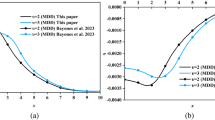Abstract
The load relaxation behavior of small Elgiloy helical extension springs has been evaluated by a combined experimental and modeling approach. Isothermal, continuous heating, and interrupted heating relaxation tests of a specific spring design were conducted. Spring constants also were measured and compared with predictions using common spring formulas. For the constant heating rate relaxation tests, it was found that the springs retained their strength to higher temperatures at higher heating rates. A model, which describes the relaxation behavior, was developed and calibrated with the isothermal load relaxation tests. The model incorporates both time-independent deformation mechanisms, such as thermal expansion and shear modulus changes, as well as time-dependent mechanisms such as primary and steady state creep. The model was shown to accurately predict the load relaxation behavior for the continuous heating tests, as well as for a complex stepwise heating thermal cycle. The model can be used to determine the relaxation behavior for any arbitrary thermal cycle. An extension of the model to other spring designs is discussed.
Similar content being viewed by others
References
J.E. Shigley and C.R. Mische: Mechanical Engineering Design, McGraw-Hill Book Company New York, 1989, p. 413.
W.D. Hanna, D.J. Chang, and G.L. Steckel: “Stress Relaxation of Spring Materials” in Proc. 32nd Aerospace Mechanisms Symposium, S.W. Walker and Edward A Boesigner, ed., NASA/CP-1998-207191, National Aeronautics and Space Administration, John F. Kennedy Space Center, Cocoa Beach, FL, 13–15 May 1998, pp. 125–40.
S.V.V. Idermark and E.R. Johansson: “Room-Temperature Stress Relaxation of High-Strength Strip and Wire Spring Steels — Procedures and Data” in Stress Relaxation Testing, ASTM STP 676, Alfred Fox, ed., American Society for Testing and Materials, Philadelphia, PA, 1979.
J.H. Gieske: Sandia National Laboratories, Albuquerque, NM, 2002, personal communication.
J.H. Gieske: Ultrasonic Measurement of Elastic Moduli of 17-4 PH Stainless Steel and Uranium — 2 Molybdenum from −40 Degrees C to 800 Degrees C, Sandia National Laboratories Report SAND80-1121, Sandia National Laboratories, Albuquerque, NM, 1980.
L. Kloc, V. Skienicka, and J. Ventruba: “Comparison of Low Stress Creep Properties of Ferritic and Austenitic Creep Resistant Steels,” Mater. Sci. Eng., 2001, A319–321, pp. 774–78.
J.C.M. Li: “A Dislocation Mechanism of Transient Creep,” Acta Metall., 1963, 11, pp. 1269–70.
R.W. Hertzberg: Deformation and Fracture Mechanics of Engineering Materials, 1st ed., John Wiley and Sons, New York, 1976, pp. 131–71.
Anonymous: Smithells Metals Reference Book, 6th ed., E.A. Brandes, ed., Butterworths, London, UK, 1983.
Author information
Authors and Affiliations
Rights and permissions
About this article
Cite this article
Dykhuizen, R.C., Robino, C.V. Load relaxation of helical extension springs in transient thermal environments. J. of Materi Eng and Perform 13, 151–157 (2004). https://doi.org/10.1361/10599490418343
Received:
Revised:
Issue Date:
DOI: https://doi.org/10.1361/10599490418343




